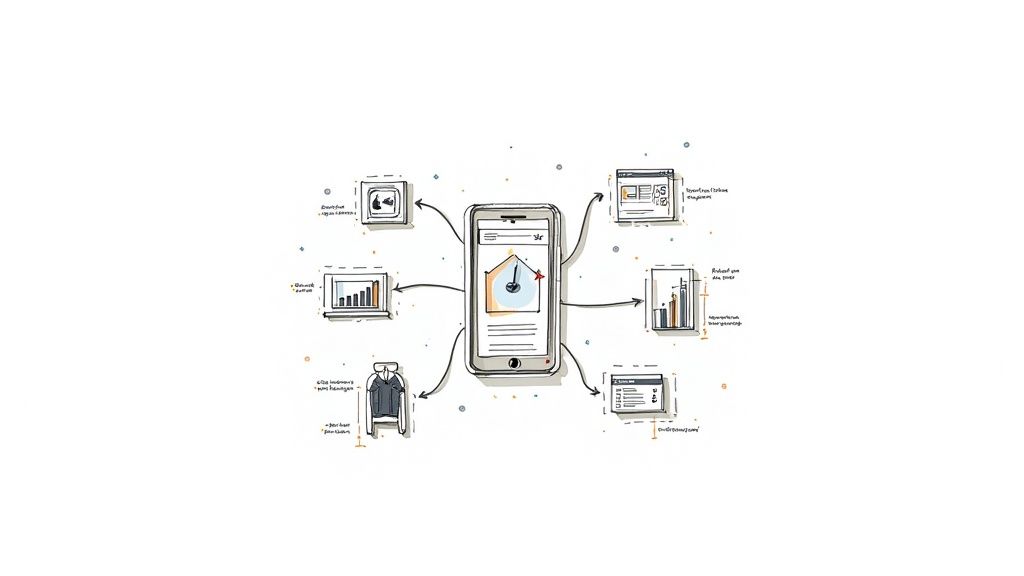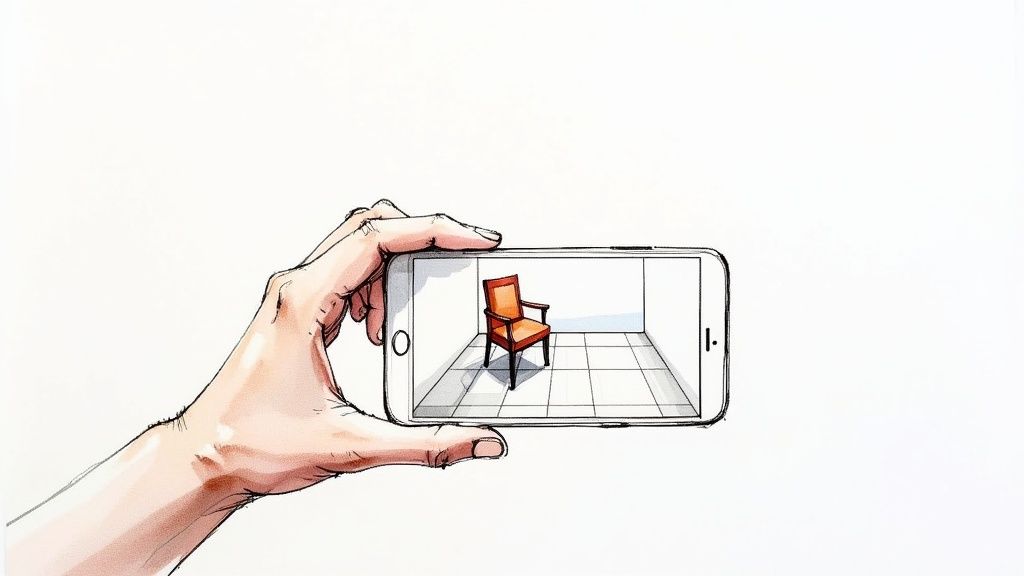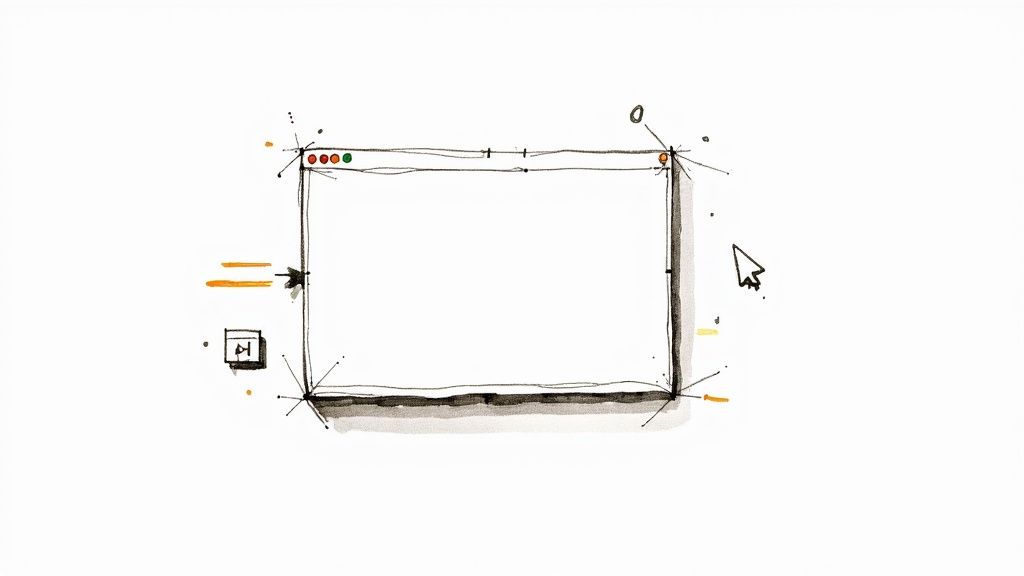
8 Interactive Ads Examples Driving Engagement in 2025
In an oversaturated market, passive scrolling has become the default user behavior. Standard static ads and auto-playing videos often fail to capture attention, resulting in low engagement and wasted ad spend. The antidote isn't louder or more frequent advertising; it's smarter, more engaging advertising. Interactive ads flip the script, transforming viewers from passive observers into active participants. This shift is a critical component of the broader digital transformation in customer experience, where brands succeed by creating value-driven, two-way conversations.
This article moves beyond theory to provide a strategic breakdown of real-world interactive ads examples. We will dissect successful campaigns across various formats, from playable video and augmented reality to gamified banners and interactive social media posts. For each example, you won't just see what the brand did; you will understand the strategic thinking behind it and get actionable takeaways to apply to your own campaigns.
You will learn:
- The specific mechanics behind high-performing interactive ads.
- How to align different interactive formats with specific marketing goals, like lead generation or brand affinity.
- Replicable strategies and tactical insights to build your own engaging ad experiences.
Forget generic success stories. This is a practical playbook for marketing professionals, sales teams, and digital agencies aiming to boost engagement, capture qualified leads, and deliver measurable results. Let's explore the campaigns that are setting a new standard for audience connection.
1. Burger King's "Whopper Detour" Playable Ad
Burger King’s “Whopper Detour” campaign stands as a legendary example of using interactive ads to drive real-world action. Instead of a passive banner, they developed a geo-fenced playable ad that gamified the user journey, directly challenging their primary competitor, McDonald's.
The ad functioned as a simple, engaging mobile game. Users were prompted to "drive" a car on a map from their current location to a nearby McDonald's. Upon arriving within the geo-fenced perimeter of the rival restaurant, the app unlocked a coupon for a 1-cent Whopper, which could then be redeemed at a nearby Burger King. This brilliant tactic turned a competitor's physical location into a trigger for their own promotion.
Strategic Breakdown
The genius of this interactive ad lies in its multi-layered strategy. It wasn't just about engagement; it was about conquesting, data acquisition, and generating massive organic buzz.
- Geofencing as a Weapon: The campaign weaponized a competitor's greatest asset, their physical footprint, against them. This created a sense of playful rebellion that resonated deeply with their target audience.
- Action-Oriented Gamification: The simple driving game was a low-friction entry point. The real goal was to prompt a physical action: downloading the BK app and visiting a store.
- Incentivized App Downloads: The 1-cent Whopper was an irresistible offer, driving over 1.5 million app downloads in just a few days. The campaign effectively paid users a Whopper to install their primary marketing channel.
Key Insight: Interactive ads are most powerful when they bridge the digital and physical worlds. The "Whopper Detour" didn't just ask for a click; it demanded a real-world "detour," creating a far more memorable brand interaction.
Actionable Takeaways for Marketers
This is a prime example of how to make interactive ads examples work for you. To replicate this success, focus on:
- Leverage Your Environment: Think about how you can use location, time of day, or even competitor presence to trigger your interactive experience.
- Create an Irresistible Incentive: The reward must be compelling enough to justify the user's action, whether it's downloading an app or visiting a store.
- Gamify the Path to Conversion: Turn the steps required for conversion into a simple, fun game. This reduces perceived effort and increases completion rates.
2. Augmented Reality (AR) Ads
Augmented Reality (AR) ads have transformed product discovery by overlaying digital information onto the user's physical world. Instead of just showing a product, AR ads allow consumers to experience it virtually through their smartphone cameras. This technology lets users “try on” makeup, visualize furniture in their living room, or interact with branded 3D models, creating a powerful and personal connection.
Brands like Sephora with its Virtual Artist, IKEA with its Place app, and Gucci with virtual sneaker try-ons have pioneered this space. They effectively remove the guesswork from online shopping, allowing customers to make more confident purchasing decisions by interacting with a digital twin of the product in their own environment. This utility-driven approach turns an ad into a valuable tool.

Strategic Breakdown
The power of AR ads comes from their ability to blend digital content with a user's personal reality, building consideration and reducing purchase friction in a way static ads cannot. The strategy is centered on utility, personalization, and shareability.
- Utility-Driven Engagement: By solving a real customer problem (e.g., "Will this couch fit in my space?" or "Will this lipstick shade suit me?"), the ad becomes a helpful tool rather than an interruption.
- Lowering Purchase Barriers: AR try-ons significantly de-risk online purchases. When a customer can see how a product looks on them or in their home, their purchase confidence soars, leading to higher conversion rates and lower return rates.
- Fostering Social Sharing: AR experiences, especially "try-on" filters on platforms like Snapchat and Instagram, are inherently shareable. Users organically become brand ambassadors by sharing their AR interactions with friends and followers.
Key Insight: The best AR interactive ads provide genuine utility, answering a customer's question before they even have to ask it. By bridging the imagination gap, they move customers from consideration to conversion much faster.
Actionable Takeaways for Marketers
This is a fantastic example of how to make interactive ads examples drive sales. To create effective AR experiences, focus on:
- Prioritize Realistic Visualization: Invest in high-quality 3D modeling and rendering. The experience is only as good as its believability, so ensure realistic lighting, shadows, and textures.
- Make It Effortless and Intuitive: The user journey must be simple. Provide clear, minimal instructions, as AR can still be a new experience for many users. Optimize for quick loading and smooth performance across devices.
- Encourage and Incentivize Sharing: Build in easy-to-use sharing buttons. Consider adding a small incentive, like a discount code, for users who share their AR experience on social media.
3. BMW's Interactive Car Configurator Banner
BMW transformed the standard display banner from a static image into a dynamic, personalized showroom with its interactive car configurator banner. Instead of just showing a picture of a car, BMW gave users direct control, allowing them to customize vehicle features like color, wheels, and trim directly within the ad unit itself.

This approach moves beyond simple awareness by inviting users to invest time and creativity into the brand experience. By interacting with the product configurator, potential customers begin the sales journey on their own terms, building an emotional connection with "their" version of the car before ever visiting a dealership or even the main company website. This is one of the most effective interactive ads examples for high-consideration products.
Strategic Breakdown
The brilliance of this ad lies in its ability to deliver a high-value, personalized experience within the constraints of a traditional banner space. It captures qualified interest by offering utility instead of just a message.
- Miniature Product Experience: The banner acts as a micro-version of the full website configurator. It provides instant gratification and a taste of the customization process, effectively pre-qualifying leads who engage.
- Data-Driven Personalization: Every click a user makes, from selecting a paint color to choosing a wheel style, is a valuable data point. This data can be used for sophisticated retargeting, showing users ads featuring the exact car they designed.
- Reduced Friction to Engagement: Users don't need to leave the page they are on to start interacting with the product. This low barrier to entry significantly increases the likelihood of engagement compared to a standard ad that requires a click-through to a landing page.
Key Insight: Interactive ads can turn passive ad space into an active lead generation tool. By offering genuine utility, like a product configurator, brands can capture user intent and data far more effectively than with a static call-to-action.
Actionable Takeaways for Marketers
To apply this strategy, marketers should focus on condensing a core brand experience into a bite-sized interaction that delivers immediate value.
- Offer a Glimpse of Customization: Allow users to personalize a product or service directly in the ad. This could be anything from changing colors to selecting package features.
- Make It a Value Exchange: Provide a useful tool or a fun mini-game rather than just an advertisement. This respects the user's time and encourages deeper interaction.
- Capture Interaction Data for Retargeting: Use the choices users make within the ad to inform your follow-up campaigns, creating a highly personalized and relevant customer journey.
4. Gamified Advertisements
Gamified advertisements transform passive viewing into active participation by embedding game mechanics directly into the ad experience. These ads leverage points, challenges, and rewards to make brand interaction feel less like a promotion and more like entertainment. A prime example is Chipotle's "Scarecrow" mobile game, which masterfully combined storytelling with simple, addictive gameplay.
In "Scarecrow," players guided a scarecrow character through a dystopian world of processed food, freeing caged animals and transporting them to a sustainable farm. The game wasn't just a diversion; it was a narrative vehicle for Chipotle's core message about "Food with Integrity." Successfully completing the game unlocked a buy-one-get-one-free offer, directly linking in-game achievement to a real-world reward and store visit.
Strategic Breakdown
Chipotle's success with this gamified ad showcases how to educate and engage simultaneously. The strategy moved beyond a simple banner to create a brand-owned entertainment property.
- Narrative-Driven Gameplay: The game’s story directly reflected Chipotle’s brand values, educating players about sustainable sourcing in a compelling, non-preachy way. This created an emotional connection, not just a transactional one.
- Skill-Based Incentives: The reward wasn't given away; it was earned. This small psychological shift made the buy-one-get-one offer feel more valuable and increased the user's investment in the brand.
- Subtle Branding, Strong Message: While the Chipotle logo was present, the focus was on the experience. The brand message was delivered through the game’s narrative, making it one of the most effective interactive ads examples for building brand affinity.
Key Insight: Gamification works best when the game's objective is intrinsically linked to the brand's core message. The fun of the game becomes synonymous with the values of the brand itself.
Actionable Takeaways for Marketers
To effectively use gamified ads, marketers should:
- Align Game Mechanics with Brand Values: Ensure the game's actions and goals reinforce your brand's mission. A game about speed could work for a delivery service, while a puzzle game might suit a tech company.
- Keep Gameplay Simple and Accessible: The goal is mass engagement, not to challenge hardcore gamers. Focus on intuitive controls and a low barrier to entry to maximize participation.
- Offer Meaningful Rewards: Provide an incentive that justifies the user's time and effort. This could be a discount, exclusive content, or early access, creating a clear path from play to purchase.
5. Interactive Social Media Ads
Interactive social media ads leverage the native features of platforms like Instagram, TikTok, and Facebook to create experiences that feel less like advertisements and more like organic content. Instead of a static image, these ads use polls, quizzes, shoppable tags, and augmented reality (AR) filters to invite direct user participation, stopping the scroll and encouraging engagement.
A great example is how e-commerce brands use Instagram's poll or quiz stickers directly within their Stories ads. A fashion brand might ask, "Which outfit would you wear for a summer brunch?" with two tappable options. This simple interaction not only boosts engagement metrics but also provides the brand with valuable, real-time feedback on product preferences, turning a simple ad into a micro-survey.
Strategic Breakdown
The power of these ads comes from their native integration and their ability to tap into the user's inherent desire to share their opinion and engage with content. They transform passive viewing into active participation.
- Platform-Native Engagement: By using features users already know and love (like polls, quizzes, or AR filters), brands lower the barrier to interaction. The ad feels like a natural part of the social media experience, not an interruption.
- Data-Driven Personalization: Each interaction provides a data point. A user's vote in a poll or answer to a quiz can be used to segment audiences for future retargeting with more relevant products and messaging.
- Encouraging User-Generated Content (UGC): Formats like TikTok’s Branded Hashtag Challenges invite users to become creators, generating a massive volume of organic content that amplifies the campaign's reach far beyond its initial paid media spend.
Key Insight: The most effective interactive social media ads don't just ask for a click; they invite users into a conversation. They leverage the "social" aspect of the platform to build community and gather insights simultaneously.
Actionable Takeaways for Marketers
These platform-specific interactive ads examples show how to blend in to stand out. To replicate this success, you should:
- Speak the Platform's Language: Tailor your interactive element to the platform. Use polls on Instagram Stories, conversational ads on Twitter, and AR filters on Snapchat or TikTok.
- Provide Instant Gratification: The interaction should provide immediate value, whether it's seeing poll results, getting a quiz score, or trying on a virtual product.
- Integrate with Your Funnel: Use the data gathered from interactions to inform your next step. If someone votes for a specific product, retarget them with an ad for that exact item. For those looking to dive deeper, you can learn more about using interactive video on a budget from Mindstamp.
6. Interactive Email Campaigns
Interactive email campaigns transform a traditionally static marketing channel into a dynamic, two-way experience. Instead of simply presenting information, these emails embed interactive elements like carousels, quizzes, accordion menus, or even product configurators directly within the email client, allowing users to engage without clicking through to a landing page.
A standout example is Burberry's use of interactive elements to launch new collections. They have sent emails featuring image carousels that users can swipe through to see different products and colorways. Another notable case is from Tesla, which has used emails that let subscribers configure a vehicle's features, like color and wheels, directly within the message, updating the hero image in real time.
Strategic Breakdown
The power of interactive email lies in reducing friction and increasing engagement within a highly personal and trusted digital space: the user's inbox. This approach turns a broadcast message into a micro-experience.
- Frictionless Engagement: By keeping the interaction within the email client, brands eliminate the extra step of visiting a website. This convenience significantly boosts engagement rates for browsing products or consuming content.
- Data-Rich Interactions: Every click on a carousel, answer to a quiz, or hover over a product is a valuable data point. This zero-party data provides deep insights into individual user preferences, enabling more effective personalization in future campaigns.
- Increased Conversion and Click-Throughs: Interactive elements like "add to cart" buttons or integrated polls naturally guide users toward a conversion action. The novelty and engagement factor also make users more likely to click through to a website for a completed action.
Key Insight: The inbox is no longer just a delivery mechanism; it's a destination. Interactive emails treat the medium as an application, providing immediate value and functionality that respects the user's time and attention.
Actionable Takeaways for Marketers
This is a fantastic way to make your interactive ads examples more direct and personal. To build effective interactive emails, consider these steps:
- Start with the Goal: Determine the primary action you want the user to take. Design an interactive element that makes taking that action simpler and more engaging, such as a poll for feedback or a carousel for product discovery.
- Ensure Graceful Degradation: Not all email clients support advanced interactivity. Always design a static fallback version that is fully functional and visually appealing to ensure a positive experience for every recipient.
- Keep It Simple and Focused: Avoid overwhelming the user with too many interactive features. Focus on one or two key elements that serve a clear purpose and guide the user intuitively toward your campaign's objective.
7. Interactive Video Shopping Ads
Interactive video shopping ads represent the convergence of entertainment and e-commerce, transforming passive video consumption into an active shopping experience. Instead of just watching a product in action, viewers can click on hotspots within the video to see product details, add items to a cart, and even complete a purchase without leaving the player.
These ads, popularized by platforms like YouTube, Amazon, and Instagram, embed commerce directly into content. A viewer watching a makeup tutorial can click on the eyeshadow being used to see its price, or someone watching a home renovation video can instantly shop for the power tools featured. This format effectively shortens the path from inspiration to purchase, capturing consumer intent at its peak.
Strategic Breakdown
The power of shoppable video lies in its ability to eliminate friction and capitalize on the moment of discovery. It’s a seamless blend of brand storytelling and direct-response marketing.
- Point-of-Inspiration Conversion: These ads allow brands to convert viewers the instant a product catches their eye. This removes the need for the user to search for the item later, a point where many potential sales are lost.
- Enhanced Product Discovery: By overlaying product information directly onto the video, brands can provide rich, contextual details that are more engaging than a static product description page.
- Data-Rich Engagement: Every click on a product hotspot provides valuable data. Marketers can analyze which products generate the most interest within a video, optimizing future content and product placement.
Key Insight: Interactive video ads succeed by closing the gap between seeing and shopping. They transform a passive viewing session into an immediate, transactional opportunity, making the advertisement itself the storefront.
Actionable Takeaways for Marketers
This is a powerful and increasingly common format among interactive ads examples. To implement this strategy effectively, marketers should:
- Integrate Seamlessly: Ensure product hotspots are clearly visible but not intrusive. The shopping elements should feel like a natural extension of the video content, not a disruptive ad.
- Optimize the Mobile Checkout: Most shoppable videos are viewed on mobile devices. The entire process, from product click to final payment, must be flawlessly optimized for smaller screens and touch-based interaction.
- Provide Rich Information Instantly: Use overlays to provide essential details like price, color options, and availability on hover or click. For a deeper dive, you can learn more about how to create an effective interactive shoppable video on mindstamp.com.
8. Interactive Out-of-Home (OOH) Digital Advertising
Interactive Out-of-Home (OOH) advertising moves beyond static billboards by transforming public displays into dynamic, engaging experiences. These ads use technologies like motion sensors, touch screens, mobile app integration, and live data feeds to react to their environment and passerby, turning a passive glance into an active brand interaction.
Campaigns like Spotify's data-driven billboards, which displayed personalized messages like "Dear person who played ‘Sorry’ 42 times on Valentine’s Day, What did you do?", showcase how to use data for clever, hyper-relevant messaging. Similarly, McDonald's has used weather-responsive digital billboards that promote McFlurrys on hot days and hot coffee when it's cold, making the ad feel timely and personally relevant.
Strategic Breakdown
The power of interactive OOH lies in its ability to create a spectacle and generate a shared public experience, which often translates into significant social media amplification.
- Contextual Relevance: These ads leverage real-time data such as weather, traffic, or even the colors of clothes people are wearing. This makes the ad feel intelligent and directly connected to the viewer's immediate reality.
- Public Spectacle and Virality: A clever interactive billboard doesn't just engage the person in front of it; it engages everyone watching. This creates a public moment that is highly shareable on social media, extending the campaign's reach far beyond its physical location.
- Surprise and Delight: By breaking the mold of traditional, passive advertising, interactive OOH creates moments of unexpected fun and utility. This fosters a strong positive emotional connection with the brand.
Key Insight: Interactive OOH blurs the line between advertising and public art. By providing a genuinely entertaining or useful experience in a public space, brands can generate organic buzz and create memorable, positive associations that a static ad could never achieve.
Actionable Takeaways for Marketers
This is one of the most visible interactive ads examples available to brands. To make it work, marketers should:
- Prioritize Simplicity: Interactions must be intuitive and achievable in seconds, as the audience is often in transit. Use clear, simple instructions like "Wave to start" or "Scan to play."
- Use the Environment as a Trigger: Design your ad to react to its surroundings. Use weather data, time of day, or even motion sensors to create a dynamic and responsive experience.
- Design for Shareability: Create a "wow" factor that encourages people to pull out their phones and record the experience. A unique visual or a surprising interaction is key to earning social media amplification.
Interactive Ads Format Comparison
Your Blueprint for Building Engaging Interactive Ads
As we’ve explored through these diverse interactive ads examples, the shift from passive consumption to active participation is no longer a trend; it's a fundamental evolution in digital marketing. The days of one-way messaging are fading, replaced by dynamic conversations that captivate, educate, and convert. From the immersive worlds of AR filters to the instant gratification of playable ads, the common thread is a commitment to providing genuine value in exchange for a user's most precious asset: their attention.
The campaigns we analyzed prove that success isn't just about adopting new technology. It’s about a strategic fusion of psychology, creativity, and data. The most effective interactive experiences are built on a deep understanding of audience motivation, leveraging game mechanics, curiosity, and the desire for personalization to forge a memorable connection.
Core Principles for Your Interactive Strategy
Reflecting on the successful campaigns from brands like IKEA, Netflix, and Zenni Optical, several core principles emerge as a blueprint for your own efforts. Mastering these will elevate your campaigns from simple novelties to powerful performance drivers.
- Value First, Always: Your interaction must offer something tangible. This could be entertainment (gamified ads), utility (AR furniture placement), discovery (interactive quizzes), or exclusive access (shoppable video). Don't ask for a click without offering a compelling reason.
- Lower the Barrier to Entry: The best interactive ads feel intuitive and effortless. A simple swipe, tap, or choice is all it should take to engage. Complicated instructions or slow loading times are the enemies of participation, so prioritize a seamless user experience.
- Align Format with Objective: The chosen format must directly support your campaign goal. A playable ad is perfect for driving app installs by offering a "try before you buy" experience. An interactive video is ideal for educating consumers about a complex product. A poll on social media excels at generating rapid engagement and gathering audience sentiment.
Actionable Next Steps to Get Started
Feeling inspired by these interactive ads examples is the first step. Turning that inspiration into action is what will drive results. Here is a practical path forward:
- Audit Your Customer Journey: Identify key touchpoints where an interactive element could remove friction or add significant value. Is it at the discovery stage, the consideration phase, or the point of purchase?
- Start Small and Test: You don't need a massive AR budget to begin. Start with a simple poll on Instagram Stories, an interactive quiz in an email newsletter, or by adding clickable hotspots to an existing video.
- Measure What Matters: Go beyond vanity metrics like impressions. Track engagement rates, time spent, click-through rates on interactive elements, and conversion lift. Use this data to refine your approach and prove ROI.
- Repurpose and Scale: A successful interactive quiz from an email campaign can be adapted into a social media ad. A popular AR filter can be promoted through interactive display banners. Find ways to leverage your winning concepts across multiple channels for maximum impact.
Ultimately, embracing interactive advertising is about respecting your audience. It’s a commitment to creating experiences that are not only seen but felt, remembered, and acted upon. By focusing on genuine engagement over passive views, you build more than just brand awareness; you build brand affinity and create a loyal customer base that feels seen and valued.
Ready to turn your existing video content into a powerful interactive experience? With Mindstamp, you can easily add clickable buttons, questions, personalization, and branching logic to any video, transforming passive viewers into active participants. Explore how easy it is to create your own interactive ads at Mindstamp.
Get Started Now
Mindstamp is easy to use, incredibly capable, and supported by an amazing team. Join us!



Try Mindstamp Free










